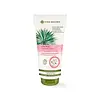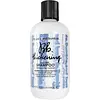What's inside
What's inside
 Key Ingredients
Key Ingredients

 Benefits
Benefits

 Concerns
Concerns

 Ingredients Side-by-side
Ingredients Side-by-side

Water
Skin ConditioningCetyl Alcohol
EmollientStearyl Alcohol
EmollientLauryl Glucoside
CleansingBehentrimonium Chloride
PreservativeCitric Acid
BufferingSodium Benzoate
MaskingIsopropyl Alcohol
SolventPanthenol
Skin ConditioningParfum
MaskingGuar Hydroxypropyltrimonium Chloride
Skin ConditioningFructooligosaccharides
HumectantInulin
Skin ConditioningEthylhexyl Salicylate
UV AbsorberTocopherol
AntioxidantGlycerin
HumectantGlycine Soja Oil
EmollientCrataegus Monogyna Flower Extract
Skin ConditioningPotassium Sorbate
PreservativeWater, Cetyl Alcohol, Stearyl Alcohol, Lauryl Glucoside, Behentrimonium Chloride, Citric Acid, Sodium Benzoate, Isopropyl Alcohol, Panthenol, Parfum, Guar Hydroxypropyltrimonium Chloride, Fructooligosaccharides, Inulin, Ethylhexyl Salicylate, Tocopherol, Glycerin, Glycine Soja Oil, Crataegus Monogyna Flower Extract, Potassium Sorbate
Water
Skin ConditioningCetearyl Alcohol
EmollientStearamidopropyl Dimethylamine
EmulsifyingBehentrimonium Chloride
PreservativeCetyl Alcohol
EmollientIsododecane
EmollientStearyl Alcohol
EmollientPhyllanthus Emblica Fruit Extract
HumectantOryza Sativa Seed Protein
AntioxidantHydrolyzed Yeast Protein
Skin ConditioningHydrolyzed Corn Protein
Skin ConditioningOryza Sativa Bran Extract
Skin ConditioningOryza Sativa Extract
AbsorbentPisum Sativum Extract
Skin ConditioningRosmarinus Officinalis Leaf Extract
AntimicrobialHelianthus Annuus Extract
EmollientOcimum Basilicum Hairy Root Culture Extract
Skin ConditioningLaurdimonium Hydroxypropyl Hydrolyzed Keratin
Skin ConditioningHelianthus Annuus Seed Oil
EmollientCocos Nucifera Oil
MaskingHydrogenated Ethylhexyl Olivate
EmollientCaprylyl Glycol
EmollientCetrimonium Chloride
AntimicrobialHydroxyethylcellulose
Emulsion StabilisingEthylhexylglycerin
Skin ConditioningAmodimethicone
Propanediol
SolventGuar Hydroxypropyltrimonium Chloride
Skin ConditioningPolysorbate 60
EmulsifyingIsopropyl Alcohol
SolventMethoxy PEG/PPG-7/3 Aminopropyl Dimethicone
Panthenol
Skin ConditioningC11-15 Pareth-7
EmulsifyingPolysilicone-12
Pentaerythrityl Tetra-Di-T-Butyl Hydroxyhydrocinnamate
AntioxidantHydrogenated Olive Oil Unsaponifiables
EmollientCyperus Esculentus Root Oil
MaskingGlycerin
HumectantTrideceth-12
EmulsifyingOctyldodecanol
EmollientAlcohol
AntimicrobialLaureth-9
EmulsifyingTocopherol
AntioxidantVp/Hexadecene Copolymer
Cystine Bis-Pg-Propyl Silanetriol
Skin ConditioningJojoba Esters
EmollientBHT
AntioxidantCitric Acid
BufferingParfum
MaskingLinalool
PerfumingBenzyl Benzoate
AntimicrobialLimonene
PerfumingHexyl Cinnamal
PerfumingButylphenyl Methylpropional
PerfumingPhytic Acid
Disodium EDTA
Phenoxyethanol
PreservativeSorbic Acid
PreservativeChlorphenesin
AntimicrobialSodium Benzoate
MaskingWater, Cetearyl Alcohol, Stearamidopropyl Dimethylamine, Behentrimonium Chloride, Cetyl Alcohol, Isododecane, Stearyl Alcohol, Phyllanthus Emblica Fruit Extract, Oryza Sativa Seed Protein, Hydrolyzed Yeast Protein, Hydrolyzed Corn Protein, Oryza Sativa Bran Extract, Oryza Sativa Extract, Pisum Sativum Extract, Rosmarinus Officinalis Leaf Extract, Helianthus Annuus Extract, Ocimum Basilicum Hairy Root Culture Extract, Laurdimonium Hydroxypropyl Hydrolyzed Keratin, Helianthus Annuus Seed Oil, Cocos Nucifera Oil, Hydrogenated Ethylhexyl Olivate, Caprylyl Glycol, Cetrimonium Chloride, Hydroxyethylcellulose, Ethylhexylglycerin, Amodimethicone, Propanediol, Guar Hydroxypropyltrimonium Chloride, Polysorbate 60, Isopropyl Alcohol, Methoxy PEG/PPG-7/3 Aminopropyl Dimethicone, Panthenol, C11-15 Pareth-7, Polysilicone-12, Pentaerythrityl Tetra-Di-T-Butyl Hydroxyhydrocinnamate, Hydrogenated Olive Oil Unsaponifiables, Cyperus Esculentus Root Oil, Glycerin, Trideceth-12, Octyldodecanol, Alcohol, Laureth-9, Tocopherol, Vp/Hexadecene Copolymer, Cystine Bis-Pg-Propyl Silanetriol, Jojoba Esters, BHT, Citric Acid, Parfum, Linalool, Benzyl Benzoate, Limonene, Hexyl Cinnamal, Butylphenyl Methylpropional, Phytic Acid, Disodium EDTA, Phenoxyethanol, Sorbic Acid, Chlorphenesin, Sodium Benzoate
 Reviews
Reviews

Ingredients Explained
These ingredients are found in both products.
Ingredients higher up in an ingredient list are typically present in a larger amount.
This ingredient is a preservative and often used for it's anti-static properties. You'll most likely see this ingredient in hair conditioners.
It does not cause irritation or sensitization in leave-on products at 1-5%.
Cetyl Alcohol is a fatty alcohol. Fatty Alcohols are most often used as an emollient or to thicken a product.
Its main roles are:
Though it has "alcohol" in the name, it is not related to denatured alcohol or ethyl alcohol.
The FDA allows products labeled "alcohol-free" to have fatty alcohols.
Learn more about Cetyl AlcoholCitric Acid is an alpha hydroxy acid (AHA) naturally found in citrus fruits like oranges, lemons, and limes.
Like other AHAs, citric acid can exfoliate skin by breaking down the bonds that hold dead skin cells together. This helps reveal smoother and brighter skin underneath.
However, this exfoliating effect only happens at high concentrations (20%) which can be hard to find in cosmetic products.
Due to this, citric acid is usually included in small amounts as a pH adjuster. This helps keep products slightly more acidic and compatible with skin's natural pH.
In skincare formulas, citric acid can:
While it can provide some skin benefits, research shows lactic acid and glycolic acid are generally more effective and less irritating exfoliants.
Most citric acid used in skincare today is made by fermenting sugars (usually from molasses). This synthetic version is identical to the natural citrus form but easier to stabilize and use in formulations.
Read more about some other popular AHA's here:
Learn more about Citric AcidGlycerin is already naturally found in your skin. It helps moisturize and protect your skin.
A study from 2016 found glycerin to be more effective as a humectant than AHAs and hyaluronic acid.
As a humectant, it helps the skin stay hydrated by pulling moisture to your skin. The low molecular weight of glycerin allows it to pull moisture into the deeper layers of your skin.
Hydrated skin improves your skin barrier; Your skin barrier helps protect against irritants and bacteria.
Glycerin has also been found to have antimicrobial and antiviral properties. Due to these properties, glycerin is often used in wound and burn treatments.
In cosmetics, glycerin is usually derived from plants such as soybean or palm. However, it can also be sourced from animals, such as tallow or animal fat.
This ingredient is organic, colorless, odorless, and non-toxic.
Glycerin is the name for this ingredient in American English. British English uses Glycerol/Glycerine.
Learn more about GlycerinThis ingredient is derived from guar gum.
It is a conditioning ingredient, meaning it helps soften skin and hair.
Isopropyl Alcohol is more commonly known as rubbing alcohol. It is most commonly used as a solvent, meaning it helps other ingredients dissolve.
This ingredient is an astringent alcohol. Astringent alcohols may also irritate skin as they high amounts may strip away your skin's natural oils.
Other types of astringent alcohols include:
According to the National Rosacea Society based in the US, you should be mindful of products with these alcohols in the top half of ingredients.
Any type of sanitizing product will have high amounts of alcohol to help kill bacteria and viruses.
Learn more about Isopropyl AlcoholPanthenol is a common ingredient that helps hydrate and soothe the skin. It is found naturally in our skin and hair.
There are two forms of panthenol: D and L.
D-panthenol is also known as dexpanthenol. Most cosmetics use dexpanthenol or a mixture of D and L-panthenol.
Panthenol is famous due to its ability to go deeper into the skin's layers. Using this ingredient has numerous pros (and no cons):
Like hyaluronic acid, panthenol is a humectant. Humectants are able to bind and hold large amounts of water to keep skin hydrated.
This ingredient works well for wound healing. It works by increasing tissue in the wound and helps close open wounds.
Once oxidized, panthenol converts to pantothenic acid. Panthothenic acid is found in all living cells.
This ingredient is also referred to as pro-vitamin B5.
Learn more about PanthenolParfum is a catch-all term for an ingredient or more that is used to give a scent to products.
Also called "fragrance", this ingredient can be a blend of hundreds of chemicals or plant oils. This means every product with "fragrance" or "parfum" in the ingredients list is a different mixture.
For instance, Habanolide is a proprietary trade name for a specific aroma chemical. When used as a fragrance ingredient in cosmetics, most aroma chemicals fall under the broad labeling category of “FRAGRANCE” or “PARFUM” according to EU and US regulations.
The term 'parfum' or 'fragrance' is not regulated in many countries. In many cases, it is up to the brand to define this term.
For instance, many brands choose to label themselves as "fragrance-free" because they are not using synthetic fragrances. However, their products may still contain ingredients such as essential oils that are considered a fragrance by INCI standards.
One example is Calendula flower extract. Calendula is an essential oil that still imparts a scent or 'fragrance'.
Depending on the blend, the ingredients in the mixture can cause allergies and sensitivities on the skin. Some ingredients that are known EU allergens include linalool and citronellol.
Parfum can also be used to mask or cover an unpleasant scent.
The bottom line is: not all fragrances/parfum/ingredients are created equally. If you are worried about fragrances, we recommend taking a closer look at an ingredient. And of course, we always recommend speaking with a professional.
Learn more about ParfumSodium Benzoate is a preservative. It's used in both cosmetic and food products to inhibit the growth of mold and bacteria. It is typically produced synthetically.
Both the US FDA and EU Health Committee have approved the use of sodium benzoate. In the US, levels of 0.1% (of the total product) are allowed.
Sodium benzoate works as a preservative by inhibiting the growth of bacteria inside of cells. It prevents the cell from fermenting a type of sugar using an enzyme called phosphofructokinase.
It is the salt of benzoic acid. Foods containing sodium benzoate include soda, salad dressings, condiments, fruit juices, wines, and snack foods.
Studies for using ascorbic acid and sodium benzoate in cosmetics are lacking, especially in skincare routines with multiple steps.
We always recommend speaking with a professional, such as a dermatologist, if you have any concerns.
Learn more about Sodium BenzoateStearyl Alcohol is a type of fatty alcohol from stearic acid. It is a white, waxy compound used to emulsify ingredients.
Fatty Alcohols are most often used as an emollient or to thicken a product. Emollients help soothe and hydrate the skin by trapping moisture.
They are usually derived from natural fats and oils and therefore do not have the same drying or irritating effect as solvent alcohols. FDA allows products labeled "alcohol-free" to have fatty alcohols.
Learn more about Stearyl AlcoholTocopherol (also known as Vitamin E) is a common antioxidant used to help protect the skin from free-radicals and strengthen the skin barrier. It's also fat soluble - this means our skin is great at absorbing it.
Vitamin E also helps keep your natural skin lipids healthy. Your lipid skin barrier naturally consists of lipids, ceramides, and fatty acids. Vitamin E offers extra protection for your skin’s lipid barrier, keeping your skin healthy and nourished.
Another benefit is a bit of UV protection. Vitamin E helps reduce the damage caused by UVB rays. (It should not replace your sunscreen). Combining it with Vitamin C can decrease sunburned cells and hyperpigmentation after UV exposure.
You might have noticed Vitamin E + C often paired together. This is because it is great at stabilizing Vitamin C. Using the two together helps increase the effectiveness of both ingredients.
There are often claims that Vitamin E can reduce/prevent scarring, but these claims haven't been confirmed by scientific research.
Learn more about TocopherolWater. It's the most common cosmetic ingredient of all. You'll usually see it at the top of ingredient lists, meaning that it makes up the largest part of the product.
So why is it so popular? Water most often acts as a solvent - this means that it helps dissolve other ingredients into the formulation.
You'll also recognize water as that liquid we all need to stay alive. If you see this, drink a glass of water. Stay hydrated!
Learn more about Water